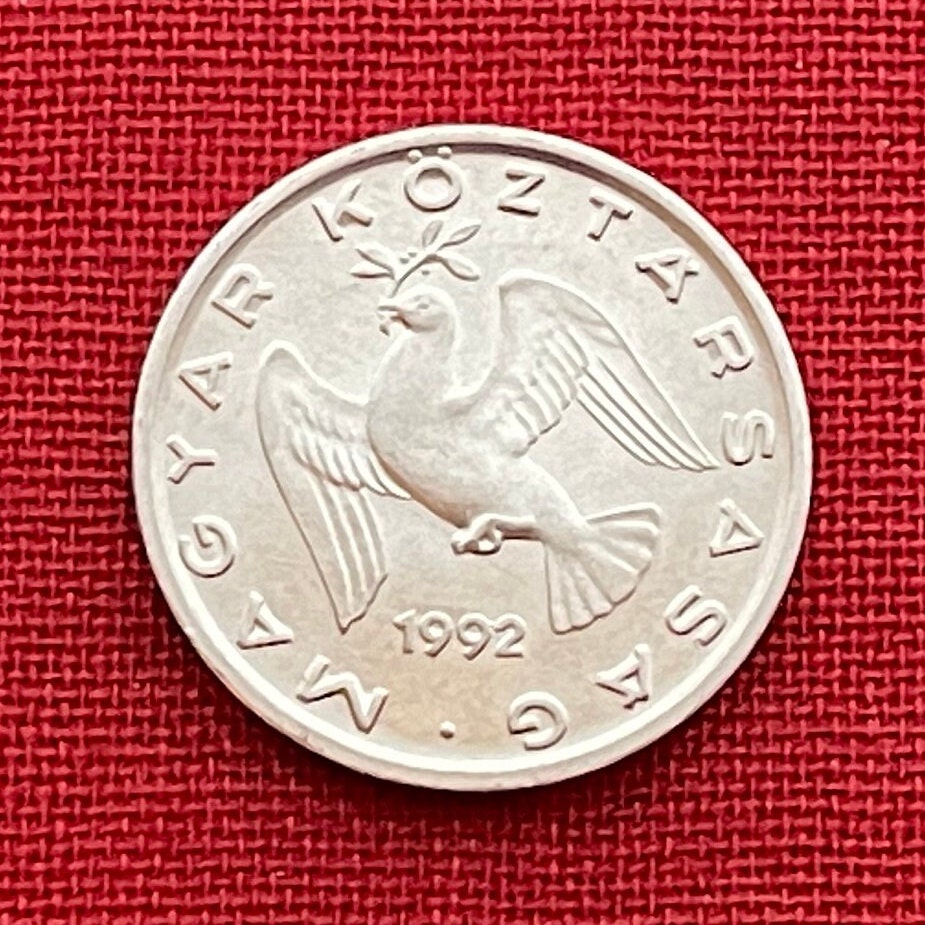elemintalshop
Dove of Peace with Olive Branch 10 Filler Hungary Authentic Coin Money for Jewelry and Craft Making
Dove of Peace with Olive Branch 10 Filler Hungary Authentic Coin Money for Jewelry and Craft Making
Couldn't load pickup availability
Dove of Peace with Olive Branch 10 Filler Hungary Authentic Coin Money for Jewelry and Craft Making
Obverse: Flying dove of peace carrying an olive branch and the date below
Lettering: MAGYAR KÖZTÁRSASÁG
Translation: Republic of Hungary
Reverse: Value
Lettering: 10 FILLÉR
Features
Issuer Hungary
Period Republic (1989-date)
Type Standard circulation coin
Years 1990-1996
Value 10 Fillér (0.10 HUF)
Currency Forint (1946-date)
Composition Aluminium
Weight 0.6 g
Diameter 18.5 mm
Thickness 1.2 mm
Shape Round
Orientation Medal alignment ↑↑
Demonetized 12-31-1997
Number N# 4057
References KM# 675, Schön# 174
Wikipedia:
The symbolism of the dove in Christianity is first found in the Old Testament Book of Genesis in the story of Noah's Ark, “And the dove came in to him at eventide; and, lo, in her mouth an olive-leaf plucked off: so Noah knew that the waters were abated from off the earth.” Genesis 8:11 And, also, in the New Testament Gospels of Matthew and Luke, both passages describe after the baptism of Jesus, respectively, as follows, “And Jesus when he was baptized, went up straightway from the water: and lo, the heavens were opened unto him, and he saw the Spirit of God descending as a dove, and coming upon him.” Matthew 3:16 and, “And the Holy Spirit descended on him in bodily form like a dove. And a voice came from heaven: “You are my Son, whom I love; with you I am well pleased.” Luke 3:22 The Holy Spirit descending on Jesus and appearing in the bodily form of a dove is mentioned in the other two Gospels as well (see Mark 1:10 and John 1:32).
The use of a dove and olive branch as a symbol of peace originated with the early Christians, who portrayed the act of baptism accompanied by a dove holding an olive branch in its beak and also used the image on their sepulchres.
Christians derived the symbol of the dove and olive branch from Greek thought, including its use of the symbol of the olive branch, and the story of Noah and the Flood. Although Jews never used the dove as a symbol of peace, it acquired that meaning among early Christians, confirmed by St Augustine of Hippo in his book On Christian Doctrine and became well established.
In Christian Iconography, a dove also symbolizes the Holy Spirit, in reference to Matthew 3:16 and Luke 3:22 where the Holy Spirit is compared to a dove at the Baptism of Jesus.[Mt 3:16]
The early Christians in Rome incorporated into their funerary art the image of a dove carrying an olive branch, often accompanied by the word "Peace". It seems that they derived this image from the simile in the Gospels, combining it with the symbol of the olive branch, which had been used to represent peace by the Greeks and Romans. The dove and olive branch also appeared in Christian images of Noah's ark. The fourth century Vulgate translated the Hebrew alay zayit (leaf of olive) in Genesis 8:11 as Latin ramum olivae (branch of olive). By the fifth century, Augustine of Hippo wrote in On Christian Doctrine that "perpetual peace is indicated by the olive branch (oleae ramusculo) which the dove brought with it when it returned to the ark".
In the earliest Christian art, the dove represented the peace of the soul rather than civil peace, but from the third century it began to appear in depictions of conflict in the Old Testament, such as Noah and the Ark, and in the Apocrypha, such as Daniel and the lions, the three young men in the furnace, and Susannah and the Elders.
Before the Peace of Constantine (313 AD), in which Rome ceased its persecution of Christians following Constantine's conversion, Noah was normally shown in an attitude of prayer, a dove with an olive branch flying toward him or alighting on his outstretched hand. According to Graydon Snyder, "The Noah story afforded the early Christian community an opportunity to express piety and peace in a vessel that withstood the threatening environment" of Roman persecution. According to Ludwig Budde and Pierre Prigent, the dove referred to the descending of the Holy Spirit rather than the peace associated with Noah. After the Peace of Constantine, when persecution ceased, Noah appeared less frequently in Christian art.
Medieval illuminated manuscripts, such as the Holkham Bible, showed the dove returning to Noah with a branch. Wycliffe's Bible, which translated the Vulgate into English in the 14th century, uses "a braunche of olyue tre with greene leeuys" ("a branch of olive tree with green leaves") in Gen. 8:11. In the Middle Ages, some Jewish illuminated manuscripts also showed Noah's dove with an olive branch, for example, the Golden Haggadah (about 1420).
Share










Great experience! Smooth transaction. Quality item! Thank you!
Beautiful coin! I love it
Coin is very clean and looks great! :)
5 stars review from Kenneth
Fast shipping and beautiful item in excellent condition.









